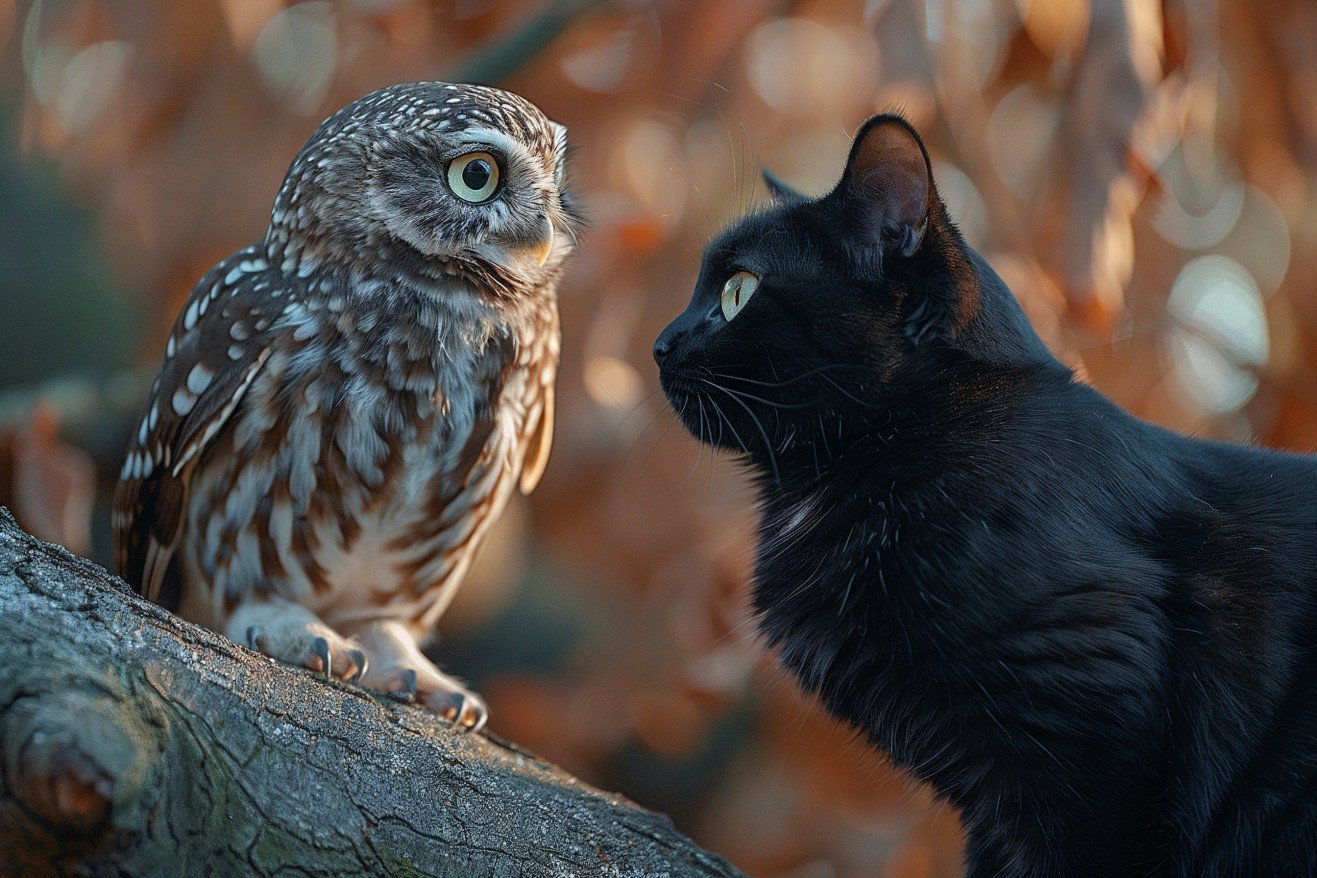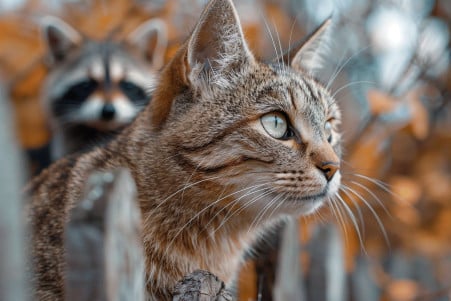Do Owls Eat Cats? The Truth About Predation
21 February 2024 • Updated 19 February 2024

As the sun sets, the owl takes to the sky in search of its next meal. Could that meal be our beloved pet cats? While owls typically eat small mammals and other birds, they have been known to eat small cats, especially when other food is hard to come by. In fact, there have been a few documented cases of large owls, like the Great-horned Owl, preying on small domestic cats.
In this article, we’ll look at a variety of studies in the fields of ornithology, urban ecology, and animal behavior to determine the relationship between owls and cats.
We’ll look at ecological research on the hunting habits of different owl species, the ways that domestic cats have adapted to living in the wild, and the interactions between the two species in different settings. After reading this article, you’ll have a good idea of how likely it is that an owl will eat a cat and the conditions that would make it more likely to happen.
Do owls eat cats?
Breaking Down the Predation Paradox in Urban Ecosystems
The “predation paradox” is a phenomenon in urban environments in which predators, like owls, are more abundant, but predation rates are lower. As one study in BioScience notes, this is due to the disruption of traditional predator-prey relationships by urbanization, which often reduces the predation pressure on native species because of the availability of human-associated food sources.
This means that even though owls may be more common in urban areas, the likelihood of them preying on small cats may not rise in tandem.
Urbanization may also alter owl behavior, which could impact their hunting behavior and territoriality. As studies in BioScience and Proceedings of the Royal Society B have shown, the availability of prey and the structure of the urban environment can impact where and how predators like owls hunt.
Meanwhile, a study in Scientific Reports found that in Australia, larger raptors are less likely to tolerate urbanization, which means smaller owls may be more likely to adapt to urban areas, which could impact their interactions with urban prey, including small pets.
As a result, the complexities of urban ecology mean that the risks to small pets are diverse. While the presence of owls in urban areas may not lead to more predation on cats, it’s important to understand the behavioral changes in these urbanized raptors to understand their potential impact.
Owl Predatory Adaptations and Their Impact on Cats
Owls are well-known for their hunting prowess, particularly in the dark. Physical and sensory adaptations, including keen eyesight, silent flight, and exceptional hearing, have made them highly specialized for hunting at night, according to Schlitz Audubon. These adaptations help ensure their survival and have also made them a danger to other animals, including small pet cats.
For example, owls have large eyes with a high concentration of light-sensitive rods, which is ideal for hunting in low light.
Their ability to rotate their heads up to 270 degrees compensates for their inability to move their eyes. According to the Owl Research Institute, the binocular vision that results from this head movement allows owls to have stereoscopic vision, which is important for accurately judging the distance to their prey.
In addition, the combination of asymmetrical ear openings and a facial disc that acts like a satellite dish to funnel sound to the ears allows owls to pinpoint their prey using sound.
Genomic studies have shown that these adaptations are the result of evolutionary pressures that have led to the development of genetic traits that favor nocturnal predation. As a result, environmental factors, including habitat and the availability of prey, have a major impact on owl hunting behavior. In some cases, especially when natural prey is scarce, these hunting adaptations may lead owls to see small cats as potential prey, even though such incidents are rare.
Getting to the Bottom of It: Owls and Their Interactions with Cats
While owl attacks on domestic cats are rare, they do happen. According to Pet Keen, larger owl species like the Great Horned Owl are even capable of carrying off small animals like fawns. This means that small cats could be at risk, especially if an owl’s typical prey is in short supply.
The International Owl Center website agrees, explaining that owls can see pets as prey when they are outside and therefore part of the food chain. In addition, because owls are opportunistic hunters, they may take advantage of the opportunity to catch a cat that is disturbing their nest or competing with them for food.
These interactions are still considered rare. According to 12news.com, urban wildlife specialists are often asked about the danger of owl attacks, especially during the nesting season when owls are more protective. However, the fact that cats are nocturnal means they are more likely to be involved in these interactions, as their active times coincide with the times when owls are hunting.
To keep pets safe, experts recommend keeping cats indoors at night and using enclosed spaces for small dogs. In addition, bright lighting in yards can help deter owls, as they tend to stay away from well-lit areas. Understanding these interactions in the complex web of urban ecosystems can help us make informed decisions that keep our pets safe while also respecting the natural behaviors of the wildlife that share our neighborhoods.
Predatory Preferences: Owls and the Dynamics of Prey Size
Owl diets can help shed light on the likelihood of owls preying on domestic cats. One article published in PMC investigates how an owl’s size impacts the size of the prey it hunts.
Larger species like the Great Horned Owl naturally hunt a wider range of prey sizes, including the occasional prey as large as a cat. This shows that an owl’s size is directly related to the size of the prey it can catch.
However, environmental factors also have a big impact on the size of the prey an owl will hunt. The Owl Research Institute explains that while most owls primarily eat rodents and other small mammals, the availability of prey and the environment can lead to an expansion of an owl’s diet.
The hunting choices of different owl species are largely dependent on the characteristics of the prey and environmental factors, as further evidenced by an article published in PMC.
Together, these factors show that while it’s possible for owls to prey on small cats, it’s not common. The size of the prey an owl will hunt and the environmental factors that lead to it hunting a certain type of prey are the reasons why these incidents are rare.
Knowing this, it’s possible to see how the complex interplay of an owl’s prey preferences impacts the safety of domestic cats in areas where they coexist with these nocturnal predators.
How Do Cats Protect Themselves from Owls?
Cats are not without defenses, and they have a number of ways to avoid or face down threats. The Cornell University College of Veterinary Medicine lists different types of aggression in cats, from play to territorial, all of which can be used as defense mechanisms against predators.
Cats’ speed and their ability to see and move in the dark help them avoid predators like owls. Cats’ senses and reflexes, often demonstrated in the sideways leap or the sudden sprint to cover, are also important for survival.
According to PetMD, defensive aggression in cats is shown through postures like crouching, hissing, and tail tucking to prevent an attack, while offensive aggression is shown through swatting and growling.
These natural responses can make a cat seem less appealing or more challenging to owls as prey. In the same vein, the ASPCA explains that cats use body language to communicate, and they may let owls know they are not easy prey through their postures.
While these methods are not guarantees against owls, they do make it less likely that a cat will be hunted. With their natural avoidance techniques and aggressive defensive behaviors, cats are less likely to be preyed upon by owls, which is why these incidents are so rare.
Owls and Cats: A Rare Interaction
In the intricate mosaic of urban wildlife, the interaction between owls and pet cats is a component that mixes infrequency with possibility. We’ve investigated the urban predation paradox, which explains that despite the growth of predators like owls in city environments, the frequency of attacks on small pets, including cats, doesn’t necessarily rise.
This is because while owls have evolved to be highly effective hunters, their adaptations are more in line with hunting natural prey than hunting cats, which have their own set of defensive adaptations.
Both documented cases and the insights of experts have shown that while owls are capable of hunting cats, it’s an unusual occurrence that often happens under specific circumstances, including a lack of other prey or the defensive behaviors of nesting owls.
A comparative study of owl prey selection has also confirmed that the size and even the location of prey can play a big role in what an owl chooses to hunt, all of which makes the hunting of cats a rare event.
Knowing this information about the behavior of owls and cats can help people ensure the two species can coexist safely and without conflict. This balance between nature and nurture also highlights the importance of responsible pet ownership and wildlife management in ensuring that our beloved pets and the beautiful wildlife that we share our world with can live together in concord.


